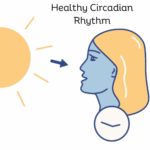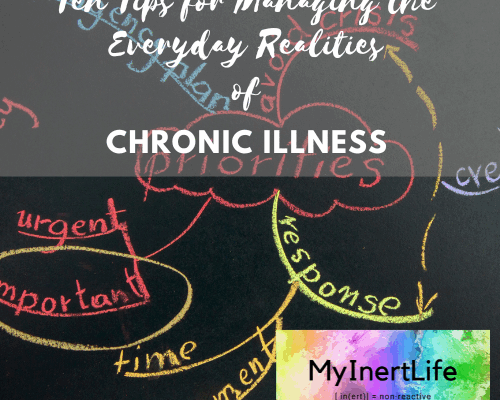This post discusses caregiver trauma as a trigger for MCAS flares. I talk about how caregiving stress is a trigger for my trauma loop, and how I’ve started to use the Safe and Sound Protocol to address trauma.
Table of Contents
What is MCAS?
Mast Cell Activation Syndrome (MCAS) is a chronic condition that affects all organ systems. MCAS is serious and disabling and people with MCAS experience often significant and debilitating symptoms daily, including anaphylaxis, which can be fatal.
MCAS is often found in combination with other chronic conditions such as Ehlers-Danlos Syndrome (EDS) and Postural Orthostatic Tachycardia Syndrome (POTS).
Frequently healthcare providers do not know about MCAS, and the tests for MCAS are problematic because they are not uniformly reliable. MCAS can be difficult to manage. Treatments include blocking mast cell mediators with anti-histamines and mast cell stabilizers, as well as avoiding triggers.
Check out this post on how to manage MCAS.
My experience with caregiver trauma
Trigger warning – this section describes my pet’s illness and symptoms.
—-
It’s taken me a while to be in a mental place to write about this because I knew I was still feeling the effects of trauma. But now three months later I feel ready.
This post shares my journey with caregiving and how stress from caregiving my daughters contributed to my MCAS.
I know from past experience that I can easily slide into caregiving mode when a family member is in crisis. It’s my default mode of operating when I don’t feel control over a situation in my family, whether my parents are sick, or my kids, spouse, or pet.
In August 3023 our 12-year-old dog started steeply declining. He actually had been diagnosed with mast cell cancer about eight years ago around the same time that my daughters received their MCAS diagnoses. There’s something to be said about pets and their people manifesting the same illnesses.
Anyway, three months ago Fisher had a big mast cell flare and chewed on one of his mast cell tumors. This led to a systemic mast cell flare and he was miserable with inflammation and pain. The tumor became so inflamed that it burst and he had to wear a cone to keep from constantly licking it.
I immediately felt myself slide into caregiving mode which was exacerbated by my husband being away visiting his family in California for ten days at the same time.
Because of Fisher’s condition, I needed to give him more care than usual, monitoring his eating, drinking, and elimination, giving him extra doses of medications and mast cell stabilizers, and I noticed the extra stress on me. I felt the familiar sense of isolation and tension intensify because I couldn’t leave him for more than an hour at a time. This caused my world to contract, and I recognized the familiar sense of lack of freedom, which leads quickly to feeling unappreciated and alone because I didn’t have any respite. This all happened automatically as Fisher’s caregiving needs intensified, and soon I felt resentful and angry — not at Fisher, but at my situation.
Luckily I recognized these familiar feelings associated with caregiving, and I started working proactively to address my feelings. But by the time I became aware of my situation, I had already started having MCAS flare symptoms. I was in the double bind of needing to address my own cascading symptoms caused by the MCAS flare while having no respite from the cause of them, while caregiving responsibilities escalated.
Reactivated trauma
On top of the actual caregiving responsibilities causing increased stress and tension, I was also dealing with reactivated trauma. My nervous system had a well-established trauma response from past caregiving stress and trauma.
I was at an osteopathic visit telling my doctor about the stress I was under with my pet when I suddenly started sobbing. I realized that the places in my body holding past trauma from the past that he was treating had been activated by my recent caregiving stress. At the same time, my osteopath articulated what I was feeling in my body — that the trauma loop in my body had been reactivated by this recent stress.
This was all helpful and validating information. It didn’t release me from caregiving responsibilities, or stop the trauma loop, but it gave me the feedback I needed to go deeper with my self-care and to switch into nervous-system healing modalities that I hadn’t remembered to use. This post covers the importance of nervous system retraining for MCAS patients. And this post discusses a particular nervous system retraining technique that is helpful when trauma is reactivated.
My osteopath also reminded me that my body will likely continue to try to use these well-worn pathways of stress and trauma in response to future stressors. He told me that this was an opportunity to notice what I was experiencing and how my nervous system was responding, and to begin to shift my mindset a little sooner each time it crops up in the future. It was empowering to understand that I could shift my long-standing response to stress and catch myself on the way to reactivating trauma sooner and sooner.
The Safe and Sound Protocol
A couple of months later I met with a new functional provider who recommended that I do the Safe and Sound Protocol developed by Steven Porges.
Stephen Porges created the Safe and Sound Protocol (SSP) as a therapeutic listening intervention designed to support the client’s emotional regulation and neuroception (i.e. sense of one’s safety), as well as decrease the client’s auditory sensitivity.
The SSP relies on the notion that when the nervous system is dysregulated you can’t actually process sounds in the middle frequencies. Sounds in the high and low frequencies correlate with screaming, distress, and bad things (think of war, explosions, etc.) When your nervous system is dysregulated you actually can’t hear frequencies in the middle of the auditory range. The SSP makes the nervous system able to hear sounds in the middle frequencies again and decreases your reactivity to sounds at the same time.
If you search Safe and Sound Procotol you can find many providers available to train you to use this modality, and there are different approaches to the therapy. I’m working with a woman in Portland, Oregon who suggests cycling through the ten hours of audio material over 20 days. I’ve done the first 10 hours of listening at 30 minutes per day while I color in a coloring book. My provider recommended doing something mindless like coloring to assist with relaxation during the SSP. She also feels that it’s good to pair breath practice with the SSP listening practice to get deeper into a parasympathetic state of rest and relaxation.
There are different approaches to the SSP. Some providers say that one cycle is good enough. My provider recommends adopting SSP as a life-long practice. I’ve just completed the first 20 days of SSP, and now I will take a break from it for 20 days before starting it up again. Then I will take another break before cycling through the audio program again. Depending on how my symptoms respond the treatment plan will be adapted in future months.
I’ve read that people with MCAS may need to go very slowly when starting brain retraining programs like SSP, Gupta, DNRS, and others. In my first SSP session, after only 90 seconds, I experienced a very big MCAS flare with neuropathy, hot flashes, and dysphoria. Luckily that same week I started taking Methylene Blue (MB), which had an immediate effect on these specific symptoms. With the combination of MB and SSP, I was able to continue the SSP listening practice without such symptom flares.
Early on in the first cycle of SSP, I noticed that certain sounds sounded different. The air purifier in my bedroom had a different pitch than before. Sounds that previously irritated me and felt intolerable were no longer an issue.
And, in the first 17 days of the first SSP cycle, I could only color with one color at a time. I colored entire meditative coloring pages with just one colored pen. On day 18 I suddenly could color with multiple colors on the same page. Somehow it had been too stimulating or too distressing to use more than one color at a time, and that abated as I did SSP.
Now that I’ve completed the first listening cycle of SSP I’ve noticed I also feel more relaxed and am less irritable with everyday stressors. Over time my provider has suggested that I’ll have more and more resilience to tension and stress, and she thinks it will even have an effect on food and environmental reactivity.
My trauma response now
We sadly had to say goodbye to Fisher in October. He was in a lot of pain and was experiencing declining overall health. We had him euthanized, and that experience in itself was trauma-inducing, in a new way for my nervous system. I had feelings of sadness and guilt, and grief to process afterward. It was the right decision for our family and for his peace, but it was still hard. Death can be hard and sad, but it can also be the right choice for an ailing pet. We gave him a beautiful last week with lots of love, special treats, and even a Christmas stocking filled with toys. His favorite holiday was Christmas.
Using SSP completely turned around the trauma response that had begun with my dog’s illness. I notice that I continue to feel more resilient and am coping better. Our family recently had the Coronavirus for the first time, which has been a big worry since 2020. However, I noticed that caregiving for family members through it didn’t trigger trauma in me. This was a huge change in my stress pattern!
The bucket theory
The bucket theory offers a helpful analogy for understanding symptom reactions with MCAS.
Think of your body as an empty bucket that you want to keep from overflowing. Different foods and activities fill your histamine bucket at different speeds but they combine to form the total level of histamine in your body (how full your bucket is). A fuller bucket means you have more histamine symptoms. When you manage triggers, reduce exposure to known triggers, and take medications and supplements to reduce histamine, you can manage the level of your bucket.
Know your typical symptom progression
Knowing your symptom progression in a symptom flare is the key to developing your own rescue plan. In this post, I discuss how to determine your own symptom progression. Once you know what typically happens in your symptom progression you can design a rescue plan to address those symptoms.
Get my free ebook, symptom log, and meal plan!
Want a tool to easily keep track of your symptoms? Sign up for my newsletter and you will receive my free 50-page ebook of lower-histamine, grain-free, sugar-free recipes, my free symptom log, and a free two-week meal plan!
What can you do about caregiver trauma
In my experience, part of the solution to caregiving trauma and stress is recognizing that it is a contributor to my MCAS. Stress is a psychosocial/emotional trigger that is raising the level of my bucket and so I look at it as a MCAS trigger, just like a triggering food or an environmental trigger.
So, the first step I take when I realize I’m experiencing caregiving stress is to look at my symptom progression to see what the likely level of my bucket is, and then to reference my rescue plan to see which supplements or therapies I should implement to start bringing down the level of my bucket.
This post discusses empowering strategies for dealing with caregiver trauma.
This post provides strategies for setting and maintaining healthy boundaries when you are in a position of caregiving.
This post discusses self-care strategies for when you have a chronic illness like MCAS and also have caregiving responsibilities.
And this post talks about the mental fatigue that comes with managing chronic illness.
Sign up for the SSP!
The SSP is a listening therapy based on Polyvagal Theory created by Stephen Porges to unlock your ability to think, feel, and connect better through nervous system regulation. You use the SSP via an app on your phone and listen with over-the-ear headphones to specially filtered music that heals the nervous system, specifically the vagus nerve. You subscribe to the app with a provider like me and listen to the specially curated music for 30 minutes each day for a 5-hour cycle. Studies show the SSP has a profound effect on mental health and chronic conditions
You can sign up for the SSP here!
Order my book!
Rocks and Roots chronicles my journey solo backpacking the Superior Hiking Trail and overcoming nervous system dysregulation, gut dysbiosis, and Mast Cell Activation Syndrome symptoms to hike 328 miles successfully.
Check out this powerful frequency device
Healy is an individualized microcurrent device I use to reduce inflammation. Check out this post for more about Healy.
Sign up for a session!
I provide one-on-one in-person and remote chronic illness and caregiver coaching and Sacred Self-Healing Sessions based on the Sacred Self-Healing Method, a proven novel co-creative healing modality detailed in my Books.
Click here for more information.
What do you think?
I’d love to have your reply below!
Disclaimer
The preceding material does not constitute medical advice. This information is for information purposes only and is not intended to be a substitute for professional medical advice, diagnosis, cure or treatment. Always seek advice from your medical doctor.





